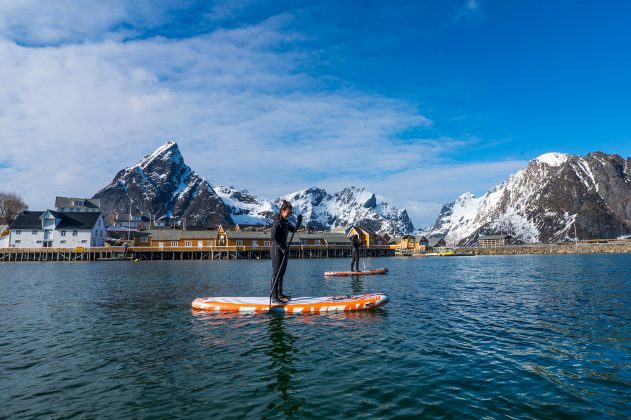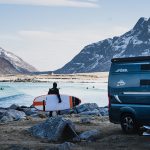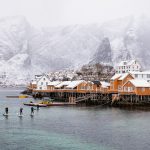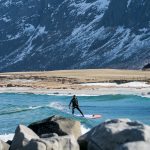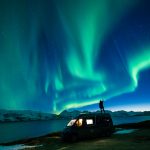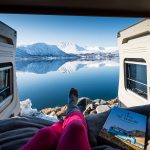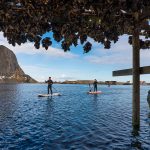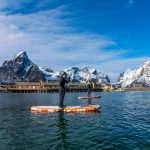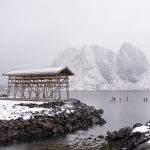MINOR THREAT
Everyone has seen Ice Age and who doesn’t love that movie when poor Zid is denied his nut because it’s frozen inside an ice cube?
Words & Photos Kari Shibevaag
The world’s climate is changing, it has always changed, and whether or not everyone agrees on the cause, this is an easily measured fact. Last summer, Norway was often sizzling in higher temperatures than Spain. That is not normal if we look at the climate history of Norway. 30 degrees sustained over several months is not normal for Norway. For sure all of us loved it, but you couldn’t help feeling that something, somewhere had gone wrong.
The North Pole was experiencing sudden temperature spikes of 20 degrees above the expected temperatures, and the sea ice around Svalbard was diminished compared to previous years, making it difficult for the indigenous polar bears to find seals, their primary food source. The stark contrasts in the Arctic unequivocally show the effects of these temperature rises, but we also feel the effects further south.
In the southern regions of Scandinavia we love it when the sun is shining, and we can SUP in just a short wetsuit, shorts or bikini. Before, we had to travel south to get long, hot sunny spells of weather. We also love it when the snow blankets the land and we can enjoy a proper winter. The classic winter days when the snow is always there, the winter cold and long. But now, the winter is also changing. This winter we’ve seen temperatures swinging wildly from over 10 degrees to – 20. Sudden dumps of up to two meters of snow in one night, and then just a few days later, it’s raining. I think the winter makes us see the anomalies clearer when you have green grass in January and then two metres of powder just outside your front door in the same week. When I was in Canada, they were experiencing the same wild swings of –20 degrees and powder, then rain in the same week.
How did we get to this situation? Well we are really just still recovering from the last ice age of 10,000 years ago when sea levels were much lower as so much of Earth’s water was locked up in the ice cap, and there was a land bridge between what we now call Russia and the USA. Great Britain was also joined to mainland Europe via the Dogger Bank but was largely devoid of life since it was buried under a vast sheet of ice.
As the planet’s temperature climbed, the ice began to melt, the sea levels rose and the ice sheet retreated north, causing among other fascinating geological effects, significant flooding the formation of ‘Rias’, large natural harbours such as the Carrick Roads and Poole Harbour. Areas that so many paddle today. This retreat of course happened thousands of years before the industrial revolution heralded our massive reliance on fossil fuels, but by a few calculations combining solar energy coming in, the albedo effect of different regions of our planet and among other things CO2 production, we can easily see that on top of this natural cycle of warming, humans are contributing to temperature rise.
Solar Artifacts
So how warm is it going to get? Today, around 80 % of the world’s energy consumption is met by gas, oil, and fossil fuels. In a perverse way, these fuel sources can be considered solar power, since in the case of coal and gas, the energy released when they are burned is the energy that the plants originally obtained from the sun which is stored in the form of chemical bonds in coal and gas. These vast reserves of fossils fuels originated in the densely vegetated swamps of the Carboniferous period some 360–300 million years ago. The Carboniferous was a time of elevated global temperature and the conditions were excellent for growing vast, dense forests. Plants satisfy their energy demands by photosynthesis, which means ultimately, fossil fuels are solar power! This solar power was collected for millions of years and then stored for 300–360 million years before humans began to extract it. Over time, layer upon layer of organic matter accumulated and became buried. In the swampy conditions, much of the material was buried faster than it could decay fully.
Eventually geologic processes buried the carbon-rich material deep enough that it is subjected to high pressure and temperature, transforming the organic matter into fossil fuels, in particular, coal. So, apart from nuclear power, we are ultimately dependent on the sun for all of our energy (even hydroelectric power is influenced by the sun). Where does this leave a place like Svalbard, where for months at a time there is not enough light to satisfy the solar panel on a pocket calculator? Let us have a quick look at the history of Svalbard.
The archipelago sits between 74 and 81 degrees north. That’s way up there with the north of Greenland. So high, that today there are around 2,000 polar bears living there and only 1,500 people. But at one time, no one lived on Svalbard. It has no indiginous population (which is why it is illegal to be registered at birth or death there). The reason that humans are there is because coal was discovered on Svalbard, and it turned out to be of a very good quality. Germany in particular, loved the stuff and it no doubt powered the production of many of the automobiles that have toured the great highways of Western Europe through the second half of the 20th century to the present day.
In 2017, the Norwegian government decided in recognisition of a boost in the geopolitical and strategic importance of the Arctic archipelago, that Norwegian coal mining in Svalbard would end. There are two caveats to this: firstly Russia still has a mine at the communist time-capsule ‘town’ of Barentsberg, and secondly, coal mining will still continue on Svalbard but only to satisfy the archipelago’s own energy demands. The coal is expected to meet the demand till 2025, and then what? They would have to import coal. How ironic and depressing that one of the regions on earth so sensitive to the effects of burning fossil fuels would be dependent not only on burning it, but on importing it on a great big stinking diesel ship. Hardly a zero-emmissions policy. So what are the alternatives?
Alternative Energy
In the summer of 2018, Norway’s Ministry of Petroleum and Energy received a report from a study it commissioned from Multiconsult and Thema Consulting Group entitled “Alternatives for future energy supply for Svalbard”. The report contains a number of proposals for future energy solutions, including a gas-fired power plant based on LNG, a thermal power plant based on pellets, and gas power combined with solar power. However, the consultants’ report contains few proposals for renewable energy solutions for the Svalbard community. The exception is a proposal for a power cable from the mainland, a very expensive solution for such a small population.
An ingenious solution was presented in a working paper from October 2018, which focused on using hydrogen as energy carrier and starting point for energy production in Svalbard. Hydrogen is completely pure and generates no CO2 emissions. The best energy utilisation is achieved by using fuel cells in the local power plant. Producing hydrogen through electrolysis is energy-intensive, but with electricity from a wind farm it can still be profitable. In addition, such projects will help reduce costs related to the use of hydrogen-based technology. Nevertheless, no future solution will provide very low-cost energy on Svalbard, the hydrogen fuel cells will also need to be transported via ship from mainland Norway.
The alternative is that everyone just leaves Svalbard to the polar bears and no one ever visits again. However governments around the world expect the ice cap to retreat further which in another strange twist in Svalbard’s future would paradoxically make it an even more significant place because with the polar ice gone, the islands would be a way point on a newly created major shipping route. Which would of course mean that its economy could support more jobs and more people would go there to live and work… Clearly solutions are not as simple as slogans on Instagram might lead us to believe. Of critical interest is when cumulative global CO2 emissions exceed the 1 trillion tons of carbon threshold, which according to the Intergovernmental Panel on Climate Change will raise the Earth’s surface temperature to 2°C above the pre-industrial minimum and trigger “dangerous interference” with the Earth’s climate system. So when will the 1 trillion ton threshold be exceeded? Best guesses say sometime between 2050 and 2055. The 2°C threshold is backed up by no hard evidence, but it was nevertheless adopted as the world’s official target in the Paris Climate Agreement, and the nations that are party to the Agreement, which include just about all of them except the US, are legally bound to pursue it.
Paid to stay home
So there we are, in around thirty year’s time (a time-span just slightly longer than Kelly Slater’s professional surfing career) we’ll either have had our final winter, or we’ll have managed to put the fossil-fuel genie back into the bottle and things will be as they are. Or we’ll be sliding towards the former from some point on the latter. Is there anything on the horizon that could swing the pendulum back in nature’s favour?
Universal basic income (UBI) on the back of the impending automative revolution and increasing use of artificial intelligence to reduce the need for human presense in not only manual jobs but also across the service industry could radically reduce the amount of commuters on roads, trains, boats and plains…Huge supra-companies will have to divvy out UBI otherwise there will be no one to buy their products and satisfy their shareholders. It sounds fanstastical but remember when IBM said there would only need to be three computers in the entire world?
We could rip up motorways, rewild our A-roads, replant hedgrows, restore oak forests and create new corridors of nature connecting our cities along paths and rivers. Want to go to the next town? Take a couple of days, no one’s in any rush now that there’s no work to go to and all our needs are comfortably met. With restored nature and improved waterways our own vicinities will be absorbing places to explore once more. Holidays will slow right down and we’ll be able to take months, instead of a few snatched days and many return trips between work, yet again reducing our travel time. Plasmic gassifiers will repurpose the plastic waste that has made its imprint on the geological record. In Japan already, several landfil sites have been emptied because with plasmic gassification trash equals money. We will be able to grow lettuces and other leafy greens to order in 24 hours in specially designed fridges (again this is already reality in Japan). Fewer trips to the shops. Reduced demand for junk food…
We should be looking towards a point in time where future generations are no longer sitting in traffic and working 50 hours a week just try and reduce their stress levels by way of retail therapy. Till then, I guess we just keep paddling. SUP International

